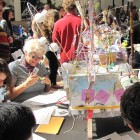
Todd Siler, Art of Science Learning’s ArtScientist in Residence, talks about this unique innovation practice which evolved out of his explorations at MIT and the application of that work to organizations around the world. METAPHORMING and the Art of Science Learning by Dr. Todd Siler Art has a way of pointing things out through implicit picture-statements that express our intuitions. These are the primary physical and conceptual ‘‘vehicles of imagination’’ that move us through the windows, doors, and open highways of our metaphors. Naturally, science does its share of pointing, too, using explicit statement-pictures and the scientific method to generate and glean discoveries. These are highlighted as hypotheses, which grow from observational science and common sense. For the past three decades, I have combined arts-based and science-based learning tools in the form of ‘‘5-D Models’’ and applied them in creative acts of innovation. I refer to these symbolic models as 5-D because they embody the traditional three dimensions of height, width and depth, as well as 4-D (time and motion perspectives); the 5th dimension encompasses all forms of symbolism or symbolic languages, such as words, images, objects, numbers, signs, stories, allegories, puns, visual metaphors, physical analogies, similes, and other devices that we use to express ourselves and communicate. Central to this work is a process I call metaphorming, which is a much deeper and more effective way of brainstorming. Participants collaborate in making multi-dimensional, freeform, symbolic models. These models contain a wealth of ideas, insights, knowledge, and creative solutions. Over the years, I have applied metaphorming to help cross-disciplinary groups produce innovative ideas and breakthroughs that lead to significant outcomes with measurable results. The process leads participants to spontaneously engage in conversations in non-contentious and non-threatening ways. Consequently, it enables people to easily connect with and better understand one another. ‘‘Metaphorming’’ comes from the Greek words meta and phora: transcending and transference. It begins with transferring new meanings and associations from one subject to another. We all do this every day on a simple level when we think in metaphors and similes. But this idea expands beyond metaphor to encompass all aspects of associative thinking. It continually creates new connections by using...


